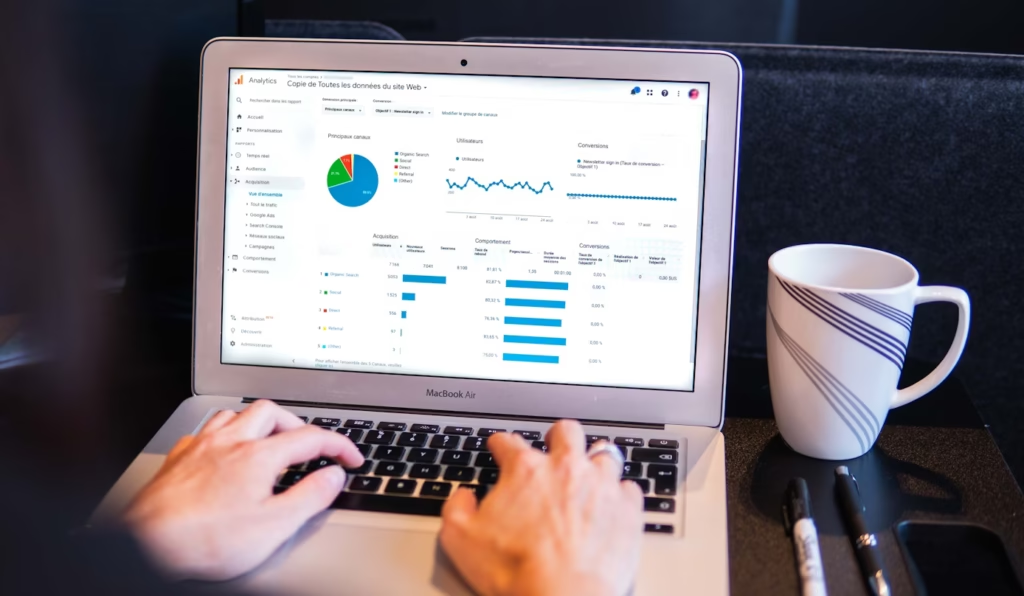Google Ads can be a powerful tool to bring more visitors to your website. It can help you reach more potential customers and boost your sales. But to get the best results, it’s important to know the right strategies.
Setting Clear Goals for Your Google Ads Campaign
Setting specific and measurable goals is key to a successful Google Ads campaign. Knowing exactly what you want to achieve helps you track progress and make needed changes. For example, instead of saying “I want more visitors,” set a specific target like “I want 500 new visitors in a month.” This clear goal will give you something to aim for and makes it easier to see if you’re succeeding.
Aligning Goals with Business Objectives
Your goals should match your overall business objectives. Think about what matters most to your business whether it’s more sales, more calls, or more email sign-ups. Make sure your Google Ads strategy supports these bigger goals. This alignment ensures that every dollar spent on ads helps you move closer to your business milestones. If you’re not sure what to choose, Google has an option to create a campaign without a goal and you can customize setting based on your marketing needs.
Choosing the Right Types of Google Ads Campaigns
Search Campaigns: Suitable for generating leads or driving website traffic. They show text ads on Google search results when people search for products or services like yours. Example goal: Increase sign-ups for a newsletter.
Performance Max Campaigns: An automated campaign type that runs across all of Google’s channels (Search, Display, YouTube, Gmail, Discover, and Maps). It uses AI to optimize bidding and targeting to meet your specified conversion goals. Example goal: Drive conversions across all Google channels with a single campaign.
Demand Gen Campaigns: These campaigns are designed to drive demand and conversions across Google’s most engaging surfaces, including YouTube, YouTube Shorts, Discover, and Gmail. They focus on visually compelling ads and audience targeting to reach potential customers at all stages of the buying journey. Example goal: Generate leads and drive conversions by engaging users with relevant, visually appealing content.
Display Campaigns: Use banner ads across websites and apps within the Google Display Network. Ideal for raising brand awareness or retargeting. Utilize visual creatives and audience targeting. Example goal: Boost brand recognition across different demographics.
Shopping Campaigns: Perfect for e-commerce businesses to showcase products directly in the search results. They allow potential customers to see your product image and price before clicking. Example goal: Increase online sales.
Video Campaigns: Show video ads on YouTube and across the Google Display Network. They can effectively build brand awareness or promote a new product. Example goal: Launch a new product with an engaging video ad showcasing product features.
App Campaigns: Promote your mobile app by running ads on Search, Display, Play Store, and other Google properties. Example goal: Increase app downloads.
Crafting Compelling Ad Copy
Tips for Writing Engaging Headlines
Creating an engaging headline is crucial. Your headline is often the first thing people see, so it has to grab their attention. Use numbers or questions to intrigue them. Keep it short but compelling. For example, “Save 50% on Winter Boots!” is better than “Great Deals on Winter Footwear.” The first headline is more direct and enticing.
Using Power Words and Emotional Triggers
Using strong words and emotional triggers can make your ad more appealing. Words like “free,” “exclusive,” and “limited time” create a sense of urgency. Emotional triggers can also be effective. Phrases like “feel great” or “peace of mind” tap into people’s feelings and make them more likely to click.
Example Google Ads Headlines
Headlines are the first thing potential customers see, and they must be compelling within 30 characters. Some examples include:
“Save Big on Watches”
“Book Now, Save More”
“New Year Deal: 30% Off”
“Join Today, Free Trial”
“Limited Offer, Act Fast”
Importance of Call-to-Actions (CTAs)
A clear call-to-action (CTA) guides people on what to do next. Without a CTA, people may just move on without taking any action. Make your CTA direct and clear. Examples include “Shop Now,” “Sign Up Today,” or “Learn More.” A strong CTA can turn viewers into customers, making your ad more successful.
Audience Targeting Techniques for Higher Conversion Rates
Utilizing Demographic Targeting
Demographic targeting lets you show your ads to the people most likely to be interested in your products or services. By narrowing your audience based on age, gender, income, or location, you can increase the chance of conversions. For example, if you sell high-end fashion, you might target women aged 25-45 in urban areas. This way, your ads reach people who are more likely to buy what you are offering.
Implementing Remarketing Strategies
Remarketing is a powerful tool. It lets you show ads to people who have already visited your website but did not take action. These are warm leads who are already familiar with what you offer. Using remarketing, you can remind them of what they liked and encourage them to come back and complete their purchase. For instance, if someone added an item to their cart but didn’t check out, a remarketing ad can nudge them to finish their purchase.
Leveraging Custom Intent Audiences
Custom Intent Audiences help you target people who are actively looking for your type of product or service. You can set up your ads to show to people who have searched for specific keywords or visited certain websites. For example, if you sell fitness gear, you could target users who have searched for “best running shoes” or “home workout tips.” This way, your ads reach people who are currently considering making a purchase.
Customer Match: Upload your customer data to target existing customers with personalized ads.
Bid Strategies Based on Business Goals
Selecting the right bid strategy can maximize your return on investment:
1. Manual CPC: Ideal if you want full control over your bidding. Suitable for smaller budgets or if conversion tracking is not yet set up. This allows careful budgeting for each click.
2. Automated Bidding: Google adjusts your bids to achieve maximum clicks, conversions, or other key actions. Best for businesses with clear conversion goals. There are multiple smart bidding strategies to choose from:
Maximize Clicks. Automatically set bids to get the most clicks within your budget. It works well for increasing website traffic with an option to control CPC bids.
Maximize Conversions or Target CPA (Cost Per Acquisition) for lead generation. Automatically set bids to get the most conversions within your budget. Suitable for high budget campaigns.
Maximize Conversion Value: Automatically set bids to get the highest conversion value within your budget. Suitable for e-commerce business. This will help you maximize the purchase order value, impacting your revenue & ROI.
Target ROAS (Return on Ad Spend): Set a target return on ad spend, and Google will optimize bids to maximize revenue based on you’re given ROAS% Target.
Conversion Tracking
Conversion tracking is crucial for measuring the success of your Google Ads campaigns. It involves setting up tracking codes on your website to see what happens after someone interacts with your ads. For instance:
E-commerce websites can track sales, completed checkouts, and terms like “Buy Now”.
Lead generation sites can monitor form submissions, sign-ups, or downloads.
Setting up conversion tracking allows you to adjust strategies based on performance data and optimize for higher ROI.
Product Feed for E-commerce
For e-commerce businesses, a product feed is essential for Shopping Campaigns. It allows Google to pull data about your products directly into ads. Key components of a product feed include:
Product title and description: Use accurate and compelling text to attract clicks.
Images: High-quality photos improve ad performance.
Price and availability: Accurate pricing information helps avoid customer frustration.
Ensure your product feed is regularly updated to reflect stock levels, prices, and new product information.
AI and Automation in Google Ads
Google Ads increasingly leverages AI and machine learning for automation.
Embrace automated bidding, responsive search ads, and Performance Max campaigns to streamline your workflow and improve efficiency.
Monitor and optimize automated campaigns regularly to ensure they align with your goals.
Conclusion
Mastering Google Ads in 2025 requires a strategic approach that incorporates the latest updates and best practices. By setting clear goals, choosing the right campaign types, crafting compelling ad copy, targeting the right audience, and leveraging automation, you can achieve remarkable campaign success.
If you need expert assistance with your Google Ads campaigns, contact GC Paid Media, a Google Ads specialist, at https://gcpaidmedia.com/. Let our expertise drive your online growth.





